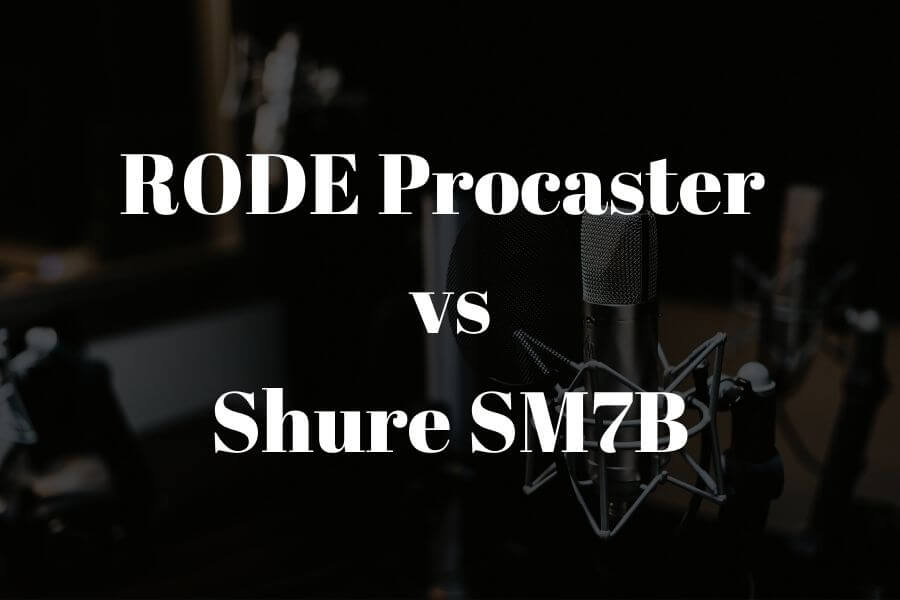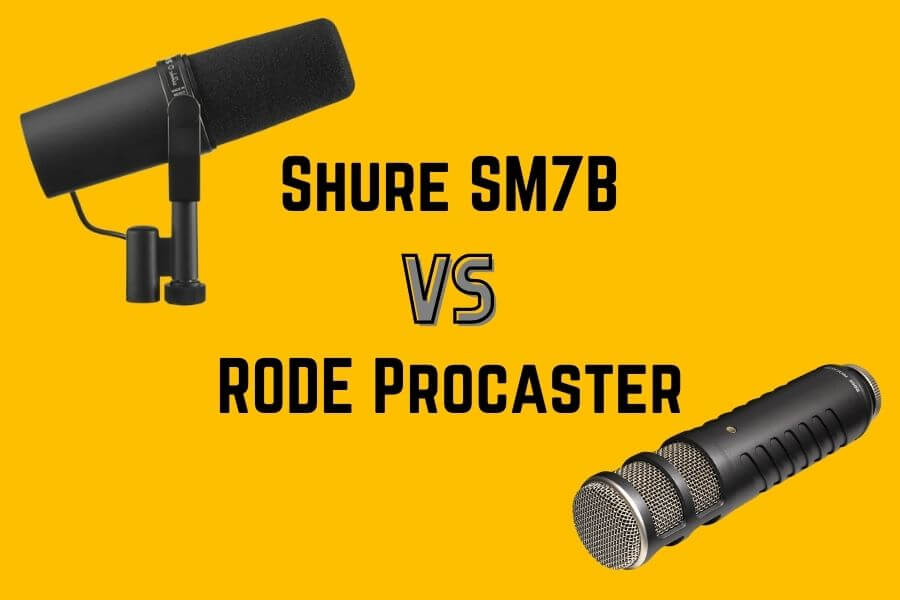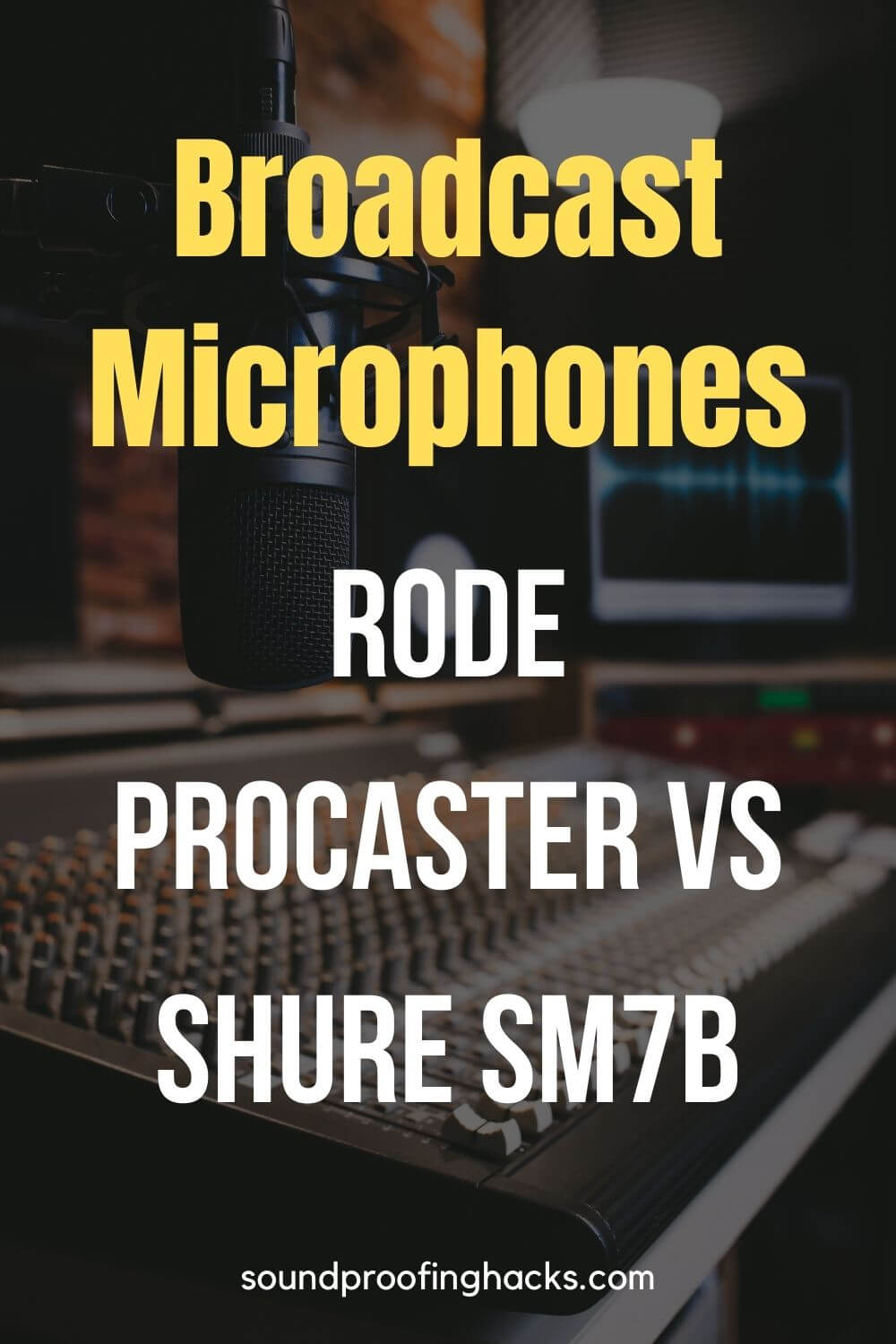RODE Procaster vs Shure SM7B – Which should you choose?
The main difference between RODE Procaster and Shure SM7B is that the RODE Procaster is a dynamic microphone while the Shure SM7B is a condenser microphone. Dynamic mics are good at loud sound sources while condenser mics are good at precision recording like vocals.
It is really amazing to me how far technology has come. Back in the days, you had to tune in to the radio at a specific time if you wanted to listen to a program, but these days, podcasts are the rage and you can listen to them anytime you want. As a podcaster, you are probably searching for the best mics to create your podcast, and in this post, we are going to take a closer look at the RODE Procaster vs Shure SM7B microphones.
After all, you cannot expect to use a random mic to record your shows and expect it to turn out professional, can you? With professional microphones, your options are expanded, not to mention the quality of your delivery to your listeners. Although they are not exactly the newest models in the market, their quality stands the test of time and is still highly relevant today.
If you are searching for a high quality and dynamic microphone for podcast or broadcast, this article might just help you to narrow down your choices.
Related: Focusrite Scarlett 2i2 Vs 2i4: Which audio interface is better for you?
I am an Affiliate for Amazon and others, which means I may make a commission if you purchase something through the links here. There is NO extra cost to you at all, and THANK YOU so much for the support. Learn more here.
Contents: Skip to section
RODE Procaster vs Shure SM7B Comparison Table
Overview of RODE Procaster and Shure SM7B

Not all microphones are made the same. Each one serves a different purpose, and ranges in quality, build, and of course the price tag. So which market does the RODE Procaster and Shure SM7B serve?
The RODE Procaster is a high quality microphone that has been used extensively for broadcast and podcasts. In fact, there are many famous podcasters that have made used of this particular model, which balances quality and value very well.
The Shure SM7B is also an excellent microphone used by broadcasters. It produces a beautiful sound quality that many people can feel right away. It does have a few additional features when compared to the RODE, but it does come in at a higher price point. Aesthetically, I think that it is one of the best designed microphones in its category.
Let’s dive in deeper to find out more.
Read this too: Rode Procaster vs Shure MV7: Which Comes Up Tops?
More about the RODE Procaster
The Procaster is made by RODE, an Australian company that specializes in audio equipment. Their products are sold all across the world and is highly regarded by many audiophiles, myself included.
At its price point, the Procaster provides exceptional value, particularly if you compare to its peers. I have seen many YouTubers use this mic for a long period of time, and it has always come away with positive reviews.
Not only is it good at recording voices for voice-overs and podcasts, they are also a great tool for recording music such as from guitars etc.
With its wide frequency range of 75-18,000Hz, it has the ability to produce very clear and crisp audio.
While recording with this mic, you can actually get up close and personal, like an inch, and still maintain the same audio quality as you would at 2-3 inches, which is widely regarded as the optimal distance. Even at further distances up to 6 inches, the quality remains the same.
At one foot back, the mic is still able to pick out sound pretty well. Pretty impressive.
The build of the Procaster is really solid. It has a lovely metal casing and has built in shock absorption and an internal pop filter which you do not find in the Shure.
Pros
- broadcast quality sound
- diverse application and can be used in many different environments, even cafes
- rich and crisp sound
- balanced and low impedance output
- superb noise rejection
- zero latency headphone jack
- internal pop filter works great
- shock absorption for smooth recording
- excellent price point
Cons
- power hungry, which means it needs more levels turned up
- needs an additional boom arm as that is not included
- needs an amp to drive up the mic
- no gain knob
More about the Shure SM7B
Probably one of the things that stand out most immediately is the hefty price tag. At most retailers, I see the Shure being about 50% more expensive than its competitors, so how does Shure justify it?
I think the first point is that Shure is a globally known brand with a long and outstanding history. Users of Shure products will attest to their workmanship and high quality builds. Mind you, this model was produced in the 70s, and it is still in production now (with upgrades of course).
For the newbie beginner, this might seem like overkill, but if someone is trying to get a mic that can outperform for a long period of time, the SM7B is a worthy investment.
With the Shure, the frequency range is wider, and it works extremely well in the studio be it for voice recording or musical instruments like the guitar. This is a weapon of choice for many professionals and amateurs alike.
In contrast with the RODE, you need to maintain close proximity with the mic, but this does not mean it is a bad thing. The noise rejection on the Shure is excellent, way more so than the RODE. Try standing a feet behind the Shure and start recording, and you will realize that your voice is the only thing that it picks up.
There are a few other features that are not present in the RODE, such as bass roll off, presence boost with mid range emphasis, and flat response.
Aesthetically, I really love the slick design of the SM7B. Similarly, it has an all metal casing which feels better to the touch, and the thicker cover can cut high frequency better. It also comes with a rotating mount which you can use on your existing mount.
Read this too: 11 Best Audacity Plugins: Free and Paid
Pros
- Natural sounds
- Low cut and high boost filters
- Effective on-board frequency response filters
- No chance of any electromagnet hum
- Excellent vocal reproduction
- Off-axis and internal noise rejection
- Reliable, consistent results
- Beautiful aesthetics
- Built-in pop filter and shock suspension
- Multi-purpose (Streaming, gaming, recording)
- Very durable, lasts a long time
Cons
- requires a lot of power to work well
- needs a pre-amp or mixer to complement it
- higher price

RODE Procaster vs SM7B comparison
In this section, we will compare the 2 models based on a few factors:
- Specifications
- Performance
- Features
Read this too: Can I use a bookshelf speaker as center channel?
Microphone specifications
Both of these broadcast microphones have a cardioid polar pattern. They both capture sounds from the front as well as from the sides to a smaller extent. For sure, there will not be any sound capture from the back of these microphones.
When it comes to the frequency range, the Shure has the advantage here as it is wider at 50-80,000Hz. This is also the most ideal range for recording vocals in my opinion. This also means that the Shure is slightly more versatile than the RODE in this department.
The SM7B does not require phantom power and is not affected if phantom power is present on its mixer input. Note that some third-party external pre-amps commonly used with the SM7B DO require phantom power to operate. You also need an audio interface between the mic and the computer. You can consider the class leading Solid State Logic SSL2.
With the RODE, it is a dynamic microphone and it only requires an adaptor. Both are using the XLR connection.
Due to the way they are set up, the Shure does have more to consider versus the RODE. I give the edge to the RODE here.
Sound performance
For performance, we look at the sound quality of these mics. Obviously, both are really high quality and produces clear, natural sounds. However, the Shure has a few more tricks in its bag.
The Shure SM7B has an audio setting on the unit itself and you can use it to to decide its sound profile right there.
Its flat or preset mode is outstanding, and when compared to the Procaster, it wins flat out. The sound is more neutral and does not have any artificial brightness to it.
This means that when recording your voice, the Shure has a more natural result which in my opinion works great for this purpose.
Of course, this can be subjective but it is good to know the profile of each before deciding. I personally think this is one of the most important factors to consider especially if you are mostly using for voice work.
Additional features
In this section, we consider what additional features each mic might have. There really isn’t much to mention here about the RODE as it has all the right features to perform well as a broadcast mic.
The Shure though, has the built in switch that allows you to turn on the low cut filter as well as mid boost, which is really convenient. The fact that the switch is unobtrusive says a lot about the design mastery Shure has.
Thanks for reading till the end. Soundproofing Hacks is supported by users like yourself. If you found our content useful, consider buying us a coffee here. It goes a long way in keeping our doors open. Thank you.
In conclusion: RODE Procaster vs Shure SM7B
I do not wish to pick an outright winner simply because I do not think there is one. A lot of it depends on your needs and the budget you are comfortable with.
It also depends on which stage of your hobby (or career) is. I should say that a complete beginner should not consider the Shure as the set up is slightly more complicated and the price point is steep.
For most people interested in creating podcasts and streaming videos, the RODE is a solid performer.
Whichever you choose, you can rest assured that you have gotten yourself a top quality microphone!
Get the Procaster here
Get the Shure SM7B here
Other articles you might be interested in:
- Do wireless headphones have a DAC?
- How to reduce keyboard noise on mic? 6 practical tips that work
- How to practice the trumpet quietly? 8 methods that work
- Wharfedale Speakers: What You Need To Know Before Getting Them

